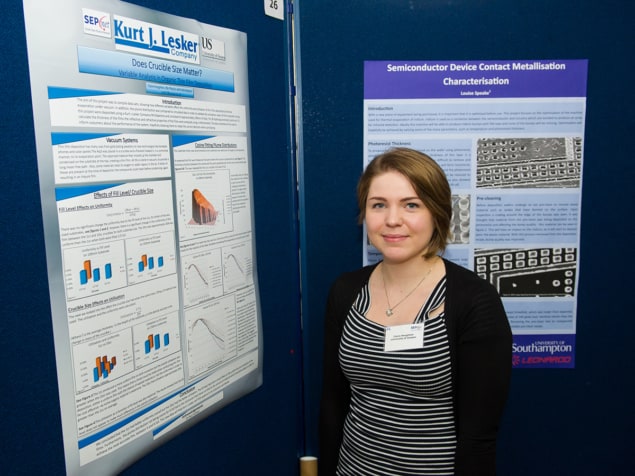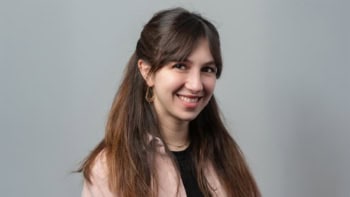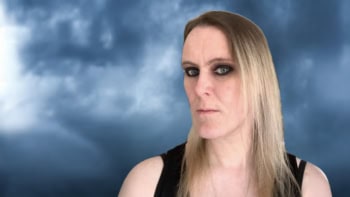Claire Houghton, an early-career physicist who works at Diamond Light Source, did two internships during her undergraduate degree in physics. She talks to Laura Hiscott about how these placements introduced her to science in the real world.
This is the fourth in a series of internship case studies that we are publishing throughout August. You can find the full series here.

While immersed in your studies, it can be hard to see the bigger picture of what physics is used for beyond academia. When Claire Houghton was studying physics at the University of Sussex, she decided that she wanted to use her physics knowledge in her future career, but she didn’t want to do a PhD, so she started looking for internships to discover what options were out there.
“I signed up for SEPnet, which the University of Sussex is part of, and I got a booklet with project summaries and profiles of companies that wanted to recruit interns for the summer.” Houghton sent a CV and cover letter to the companies that she was interested in, and was invited to an interview at Kurt J Lesker, a company that makes vacuum products for research equipment.
After being offered an internship, Houghton moved to Hastings for the summer, where the UK branch of the company is based. She worked on a project looking at vapour deposition to create thin films of material, and investigating how the quantities of material deposited would affect the properties of the end product. “That was really exciting because I got to run experiments and learn to use real equipment.”
The following summer, she did another placement through SEPnet, this time at Adaptix – a medical-physics company in Oxfordshire, UK, where she worked on a design for a portable 3D X-ray machine. “I was looking at the percentage of electrons that were lost depending on the set-up, to find the electric field that would maximize the number of electrons getting to the place where they would generate X-rays. At university you always talk about the theory of things, but actually seeing the application of the physics that I’d been learning was really exciting.”
Working in the real world comes with its hazards though. While running one experiment, Houghton began to hear sparks, and see flashes like lightning, indicating that the electron paths had gone wrong. “It looked like the beginnings of a fantasy movie where someone’s going to get hit by X-rays and turn into some kind of superhero,” she says. “We had to press the big red emergency button to stop the experiment. It was one of the most nerve-wracking things I’ve ever done. You always see these big red buttons and think it would be terrible to have to press that. Luckily we switched it off in time, so nothing got broken.”
For both internships Houghton moved to a new place. “That was exciting as I got to explore a new area and it made it feel like a real job.” She also joined in with social activities. “At Adaptix we would go out for drinks together some evenings, and we had a sports day with other companies that were based at the same site as Adaptix, which was fun. Watching all these very smart scientists doing three-legged races was funny.”
Houghton now works at Diamond Light Source, a synchrotron facility in Oxfordshire, and she uses many of the skills she developed during her internships. “I really enjoyed the mesh of theory and practice, and my current job has both elements. I work on diagnostics, using experiments and simulations to understand the reason for something going wrong,” she says. “Often at university you don’t see things go wrong in experiments – or if you do, then you already know the reason. The internships gave me an idea of real scientific experiments where no-one knows exactly what’s going to happen, so things might not work perfectly, and part of it is working out why. I really enjoyed that problem-solving aspect.”

Summer internships: Maria Violaris – ‘I developed general research skills, which are useful in both industry and academia’
As well as helping Houghton decide on her future career, the internships also proved valuable when it came to applying for jobs. “At the end of both internships I created a poster or a report on my project. That’s something you can take with you to an interview and show as concrete examples when they ask about when you’ve used problem-solving skills or worked in a team. It also shows that you’ve thought about what you want to do, rather than just applying for any jobs you see after graduating.”
To find an internship, Houghton suggests going to your university careers office, because they will know about opportunities in your area, and also signing up to a mailing list for internships and graduate schemes.
“Apply to everything that interests you, even if you don’t think you have enough experience. A lot of places looking for interns know that people won’t have experience, but they know that you have gained a lot of skills while studying physics, and you should trust that you have too, even if it doesn’t feel like it. Both internships were really useful in seeing how I could use those skills in my career.”



